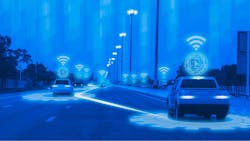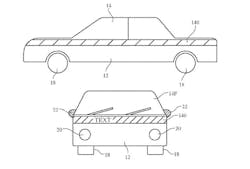Apple Granted Two Patents for Self-Driving Car Systems
What you'll learn:
- What are the main components of Apple's "Exterior Lighting and Warning System"?
- What are the unique innovations with the new occupant safety system?
- A system where computing devices work cooperatively.
Patents provide incentives to, and protection for, companies by offering them recognition for their creativity and the possibility of material reward for their inventions. But being granted a patent doesn’t mean the idea will appear in a future product.
Apple, like most tech companies, files patent applications on a regular basis. However, while the existence of a patent indicates the area of interest for Apple's research and development labors, it doesn't guarantee that Apple will enter the automotive arena. It is known, though, that Apple has been working for years on Project Titan, related to autonomous vehicles.
The U.S. Patent and Trademark Office (USPTO) recently granted two patents to Apple related to self-driving cars. The first patent covers a new exterior lighting system conveying various warnings to surrounding vehicles in the form of text or visual displays. The second granted patent covers an occupant safety system with inflatable restraints deployable to protect occupants in vehicles with non-traditional seating (which could occur if you don’t have a steering wheel or pedals taking up space).
One of the problems facing autonomous vehicles is indicating to other drivers what the vehicle will do next. Unlike seeing the driver ahead to get an idea about where he or she is about to go, there may not be the same opportunity in a driverless vehicle.
Apple proposes to be more explicit in what a self-driving system can tell other road users. Instead of the usual external indicator lights, Apple believes it can rely on a more complex external lighting system.
Advanced Exterior-Lighting Warning System
With Apple’s “Exterior Lighting and Warning System” an advanced display system of an autonomous car would show information to the other road users about the next maneuvers of the vehicle. According to the patent, the vehicle lighting system would consist of control circuitry, one or more sensors, and a light-based display device. For example, the sensor would detect the distance in between cars and if it finds the following car is getting too close, the device will display information accordingly.
The system also could alert following drivers that the self-driving vehicle is about to travel left or right, give a countdown for actions, and other messages. They can be text, but also could consist of graphics and video. Roadway information also may be displayed (e.g., “fog ahead on roadway," "traffic congestion in one mile," etc.).
In short, Apple's system involves the creation of displays that are placed on and around the vehicle. The type of light emitter could be LEDs or other light-based technology, including OLEDs and LCD display panels. Moreover, the displays could show practical information in multiple colors, including symbols, text, numbers, and other patterns.
Control circuitry may use these light-based devices to display braking information, information on vehicle speed, the relative speed between a vehicle and a following vehicle, autonomous-driving mode status, information on risks if a collision between a vehicle and an external object is imminent, or other user-selected information.
Occupant Safety System
Within a traditional one-, two-, or three-row vehicle during a collision, occupants are protected from loose objects placed on empty seats, such as backpacks or electronic devices, by seat backrests acting as barriers. The backrests impede motion of the loose objects between the rows of seats. In non-traditional vehicle designs, for example, where rows of occupants face each other within the passenger compartment, there are limited options for tethers and loose-object handling. New approaches to occupant safety systems are desired.
The second patent granted to Apple involves a rear-facing seat securing a rear-facing occupant opposing a front-facing seat. During a front collision, the occupants can be at risk of hitting each other. High loads also may be imposed on chests and necks of the occupants in the absence of safety measures beyond traditional tensioned restraints. Apple believes a dynamic seating system can be used to reposition the seats to lessen risk of injury to occupants during a collision.
Apple’s proposed occupant safety systems are said to be suitable for use in non-traditional vehicles, such as those with opposed seating systems and lacking traditional airbag packaging and surfaces (e.g., dash panels and steering wheels). It would feature cabin dividers and restraints that increase safety during a collision for occupants facing each other. Examples of this include tensioned restraints and inflatable restraints such as self-tethered airbags, seatbelt and/or lapbelt airbags, roof and/or door airbags, etc.
According to the patent, a top-of-the-roof airbag can be configured to decouple from, and become spaced from, the roof of the vehicle upon deployment. It would move downward into the vehicle cabin to a position configured to restrain the head and torso of the occupant during the imminent collision.
Again, according to Apple, occupant safety systems suitable for use in both traditional and opposed seating systems include various combinations of passive safety components: sensors that provides an output signal indicative of an imminent collision and safety-system seats that selectively move relative to seat support structures in response to the output signal. Other components would be a control unit that controls the force applied to the seat facing a second seat in the opposed seating system, and a motion-control device enabling the first seat to move away from the second seat during the collision.
The cabin divider described in the patent features a pair of side arms; each side arm is extendable between a stowed position on the roof of the vehicle and a deployed position on a side of the vehicle. The cabin divider also has a blocking material stretched along a length of each of the side arms and extending between the pair of side arms.
The use of these safety features also would allow for increased options in packaging and design in all vehicle passenger compartments regardless of the seating configuration.
Computing Cooperation
Finally, the patent discusses a system that includes multiple computing devices working cooperatively. For instance, the computing device can be a vehicle-based control unit or a vehicle engine control unit (ECU). Alternatively, the computing device may be a desktop computer, laptop computer, tablet, or mobile device such as a smartphone.
In the example where the computing device is a control unit, the unit could send commands to various components of the safety systems. For instance, the control unit can send commands to belt tensioners, airbag inflators, seat motors, tether couplings, etc. to cause deployment of airbags, deployment of cabin dividers, motion of seats in a dynamic seating system, etc.
In the patent, a computing device is defined as including a processor, memory device, storage device (which can be a hard-disk or solid-state drive), one or more input devices, and one or more output devices that are interconnected by a bus. The computing device also may incorporate a bus interface for connecting peripheral devices to the bus. As an example, the processor could be a conventional central processing unit (CPU). Although the Apple example shows a single processor, multiple processors can be used.

